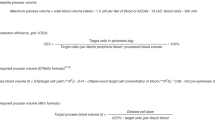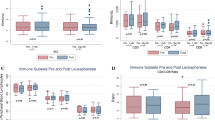Abstract
Collection of CD3+ lymphocytes via lymphapheresis is essential for manufacturing autologous chimeric antigen receptor (CAR) T cells. Optimization of timing and procedures for lymphapheresis for each patient is critical because patients often have progressive diseases and receive medications that could reduce T cell counts. We conducted a retrospective study of clinical data from 28 patients who underwent lymphapheresis for CD19-directed CAR-T therapy with tisagenlecleucel to identify factors that could affect CD3+ lymphocyte yields. The numbers of CD3+ cells in peripheral blood were significantly correlated with CD3+ cell yields (correlation coefficient r = 0.84), which enabled us to estimate the volume of blood to process before apheresis. We also found that small cell ratio (SCR) at the apheresis site precisely reflected the proportion of lymphocytes, especially in patients without circulating blasts (coefficient of determination: r2 = 0.9). We were able to predict the CD3+ cell yield and prevent excessive apheresis by measuring pre-apheresis circulating CD3+ cell counts and monitoring SCR. Collectively, these results will help us to establish a strategy for optimization of lymphapheresis procedures for CAR-T cell production on a patient-by-patient basis.




Similar content being viewed by others
References
Kalos M, Levine BL, Porter DL, Katz S, Grupp SA, Bagg A, et al. T cells with chimeric antigen receptors have potent antitumor effects and can establish memory in patients with advanced leukemia. Sci Transl Med. 2011;3(95):95ra73. https://doi.org/10.1126/scitranslmed.3002842.
Porter DL, Kalos M, Zheng Z, Levine B, June C. Chimeric antigen receptor therapy for B-cell malignancies. J Cancer. 2011;2:331–2. https://doi.org/10.7150/jca.2.331.
Porter DL, Levine BL, Kalos M, Bagg A, June CH. Chimeric antigen receptor-modified T cells in chronic lymphoid leukemia. N Engl J Med. 2011;365(8):725–33. https://doi.org/10.1056/NEJMoa1103849.
Maus MV, Levine BL. Chimeric antigen receptor T-cell therapy for the community oncologist. Oncologist. 2016;21(5):608–17. https://doi.org/10.1634/theoncologist.2015-0421.
Wang X, Rivière I. Clinical manufacturing of CAR T cells: foundation of a promising therapy. Mol Ther Oncolytics. 2016;3:16015. https://doi.org/10.1038/mto.2016.15.
Gill S, Maus MV, Porter DL. Chimeric antigen receptor T cell therapy: 25 years in the making. Blood Rev. 2016;30(3):157–67. https://doi.org/10.1016/j.blre.2015.10.003.
Lee DW, Kochenderfer JN, Stetler-Stevenson M, Cui YK, Delbrook C, Feldman SA, et al. T cells expressing CD19 chimeric antigen receptors for acute lymphoblastic leukaemia in children and young adults: a phase 1 dose-escalation trial. Lancet. 2015;385(9967):517–28. https://doi.org/10.1016/S0140-6736(14)61403-3.
Brentjens RJ, Rivière I, Park JH, Davila ML, Wang X, Stefanski J, et al. Safety and persistence of adoptively transferred autologous CD19-targeted T cells in patients with relapsed or chemotherapy refractory B-cell leukemias. Blood. 2011;118(18):4817–28. https://doi.org/10.1182/blood-2011-04-348540.
Grupp SA, Kalos M, Barrett D, Aplenc R, Porter DL, Rheingold SR, et al. Chimeric antigen receptor-modified T cells for acute lymphoid leukemia. N Engl J Med. 2013;368(16):1509–18. https://doi.org/10.1056/NEJMoa1215134.
Brentjens RJ, Davila ML, Riviere I, Park J, Wang X, Cowell LG, et al. CD19-targeted T cells rapidly induce molecular remissions in adults with chemotherapy-refractory acute lymphoblastic leukemia. Sci Transl Med. 2013;5(177):177ra38. https://doi.org/10.1126/scitranslmed.3005930.
Kochenderfer JN, Dudley ME, Feldman SA, Wilson WH, Spaner DE, Maric I, et al. B-cell depletion and remissions of malignancy along with cytokine-associated toxicity in a clinical trial of anti-CD19 chimeric-antigen-receptor-transduced T cells. Blood. 2012;119(12):2709–20. https://doi.org/10.1182/blood-2011-10-384388.
Kochenderfer JN, Dudley ME, Kassim SH, Somerville RP, Carpenter RO, Stetler-Stevenson M, et al. Chemotherapy-refractory diffuse large B-cell lymphoma and indolent B-cell malignancies can be effectively treated with autologous T cells expressing an anti-CD19 chimeric antigen receptor. J Clin Oncol. 2015;33(6):540–9. https://doi.org/10.1200/JCO.2014.56.2025.
Savoldo B, Ramos CA, Liu E, Mims MP, Keating MJ, Carrum G, et al. CD28 costimulation improves expansion and persistence of chimeric antigen receptor-modified T cells in lymphoma patients. J Clin Invest. 2011;121(5):1822–6. https://doi.org/10.1172/JCI46110.
Schuster SJ, Bishop MR, Tam CS, Waller EK, Borchmann P, McGuirk JP, et al. Tisagenlecleucel in adult relapsed or refractory diffuse large B-cell lymphoma. N Engl J Med. 2019;380(1):45–56. https://doi.org/10.1056/NEJMoa1804980.
Garfall AL, Maus MV, Hwang WT, Lacey SF, Mahnke YD, Melenhorst JJ, et al. Chimeric antigen receptor T cells against CD19 for multiple myeloma. N Engl J Med. 2015;373(11):1040–7. https://doi.org/10.1056/NEJMoa1504542.
Allen ES, Stroncek DF, Ren J, Eder AF, West KA, Fry TJ, et al. Autologous lymphapheresis for the production of chimeric antigen receptor T cells. Transfusion. 2017;57(5):1133–41. https://doi.org/10.1111/trf.14003.
Bolan CD, Yau YY, Cullis HC, Horwitz ME, Mackall CL, Barrett AJ, et al. Pediatric large-volume leukapheresis: a single institution experience with heparin versus citrate-based anticoagulant regimens. Transfusion. 2004;44(2):229–38. https://doi.org/10.1111/j.1537-2995.2004.00668.x.
Hutt D, Bielorai B, Baturov B, Z’orbinski I, Ilin N, Adam E, et al. Feasibility of leukapheresis for CAR T-cell production in heavily pre-treated pediatric patients. Transfus Apher Sci. 2020. https://doi.org/10.1016/j.transci.2020.102769.
Tuazon SA, Li A, Gooley T, Eunson TW, Maloney DG, Turtle CJ, et al. Factors affecting lymphocyte collection efficiency for the manufacture of chimeric antigen receptor T cells in adults with B-cell malignancies. Transfusion. 2019;59(5):1773–80. https://doi.org/10.1111/trf.15178.
Stroncek DF, Ren J, Lee DW, Tran M, Frodigh SE, Sabatino M, et al. Myeloid cells in peripheral blood mononuclear cell concentrates inhibit the expansion of chimeric antigen receptor T cells. Cytotherapy. 2016;18(7):893–901. https://doi.org/10.1016/j.jcyt.2016.04.003.
Acknowledgements
We acknowledge the technical staffs at Center for Cellular and Molecular Medicine, Kyushu University Hospital for flow cytometric analysis and the clinical engineering technologists at Department of Medical Technology, Kyushu University Hospital for assistance with procedure of apheresis. We also thank the apheresis nurses at Blood Transfusion Center, Kyushu University Hospital for clinical care contributions.
Author information
Authors and Affiliations
Corresponding author
Ethics declarations
Conflict of interest
The authors declare no competing financial interests.
Additional information
Publisher's Note
Springer Nature remains neutral with regard to jurisdictional claims in published maps and institutional affiliations.
About this article
Cite this article
Yamanaka, I., Yamauchi, T., Henzan, T. et al. Optimization of lymphapheresis for manufacturing autologous CAR-T cells. Int J Hematol 114, 449–458 (2021). https://doi.org/10.1007/s12185-021-03191-x
Received:
Revised:
Accepted:
Published:
Issue Date:
DOI: https://doi.org/10.1007/s12185-021-03191-x




